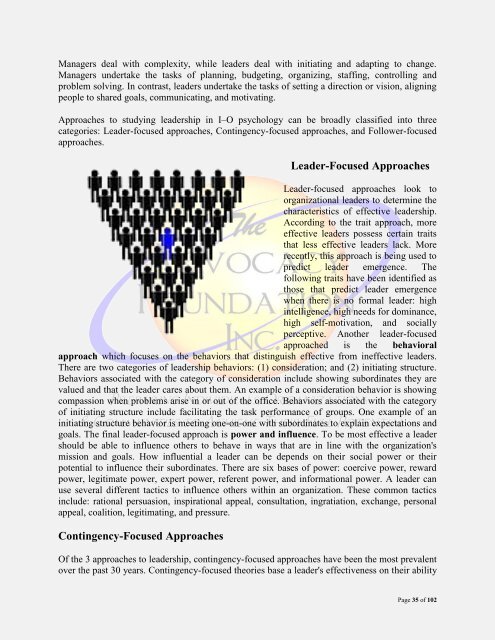Organizational Psychology - Vol. VI, Part III
Organizational Psychology - Vol. VI, Part III
Organizational Psychology - Vol. VI, Part III
You also want an ePaper? Increase the reach of your titles
YUMPU automatically turns print PDFs into web optimized ePapers that Google loves.
Managers deal with complexity, while leaders deal with initiating and adapting to change.<br />
Managers undertake the tasks of planning, budgeting, organizing, staffing, controlling and<br />
problem solving. In contrast, leaders undertake the tasks of setting a direction or vision, aligning<br />
people to shared goals, communicating, and motivating.<br />
Approaches to studying leadership in I–O psychology can be broadly classified into three<br />
categories: Leader-focused approaches, Contingency-focused approaches, and Follower-focused<br />
approaches.<br />
Leader-Focused Approaches<br />
Leader-focused approaches look to<br />
organizational leaders to determine the<br />
characteristics of effective leadership.<br />
According to the trait approach, more<br />
effective leaders possess certain traits<br />
that less effective leaders lack. More<br />
recently, this approach is being used to<br />
predict leader emergence. The<br />
following traits have been identified as<br />
those that predict leader emergence<br />
when there is no formal leader: high<br />
intelligence, high needs for dominance,<br />
high self-motivation, and socially<br />
perceptive. Another leader-focused<br />
approached is the behavioral<br />
approach which focuses on the behaviors that distinguish effective from ineffective leaders.<br />
There are two categories of leadership behaviors: (1) consideration; and (2) initiating structure.<br />
Behaviors associated with the category of consideration include showing subordinates they are<br />
valued and that the leader cares about them. An example of a consideration behavior is showing<br />
compassion when problems arise in or out of the office. Behaviors associated with the category<br />
of initiating structure include facilitating the task performance of groups. One example of an<br />
initiating structure behavior is meeting one-on-one with subordinates to explain expectations and<br />
goals. The final leader-focused approach is power and influence. To be most effective a leader<br />
should be able to influence others to behave in ways that are in line with the organization's<br />
mission and goals. How influential a leader can be depends on their social power or their<br />
potential to influence their subordinates. There are six bases of power: coercive power, reward<br />
power, legitimate power, expert power, referent power, and informational power. A leader can<br />
use several different tactics to influence others within an organization. These common tactics<br />
include: rational persuasion, inspirational appeal, consultation, ingratiation, exchange, personal<br />
appeal, coalition, legitimating, and pressure.<br />
Contingency-Focused Approaches<br />
Of the 3 approaches to leadership, contingency-focused approaches have been the most prevalent<br />
over the past 30 years. Contingency-focused theories base a leader's effectiveness on their ability<br />
Page 35 of 102

















